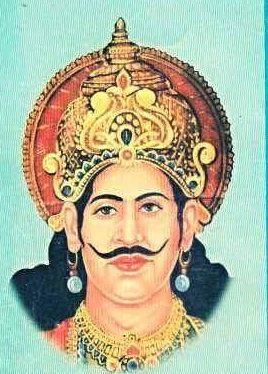The Nandas which were later succeeded by the Mauryas are known to be the first empire of ancient India. Their achievements have been mentioned in Puranas, Buddhist, Jain, and foreign texts.

The Greeks who came to India during the time of Alexander also described the prosperity of the Nanda Empire. Furthermore, in their texts, they mentioned their strong army and immense riches.So who were these Nandas and how did they carve out such a big empire that stretched across northern India? We will shed light on the untold chapter of the Nandas and its forgotten tale.
Content
Background: Origin and Early History of the Nandas
Known as Ekarat/Ekksatra i.e. Soul Soveregin Rulers according to the Puranas the origin of the Nandas is still a topic of debate. Several texts speak different facts regarding their origin.
The writing of Greek scholars like Deodorus, and Curtius suggests that the founder of the Nanda Empire was none other than Agrammes.
Furthermore, according to Curtius, the Nandas might belong o low origin as he had quoted in his writings
Chandragupta Maurya reported to Alexander that the present king was not merely a man originally of no distinction but even of the very meanest condition his father in fact was a barber.
Thus the Greek texts referred to the founder of this Empire as a barber.
Coming to the Buddhist, Jain, and Puranic sources the founder of the Nanda Empire has different names in all these sources. For Buddhist sources (according to Mahavamsatika) the first king of this dynasty was called Ugrasena who is mentioned as Annatakula i.e. of unknown lineage.
The Jain source called Parishistaparvan mentioned them as the son of the Barber. According to Avasyaka Sutra, the Nandas are also mentioned as Barber.
The Puranas mentioned them as Adharmika and its founder is known as Mahananda.
“According to Vishnu Puran The son of Mahananda will be born of a woman of the Sudra his name will be Nanda called Mahapadma, for he will be exceedingly avaricious, like another Parasurama, he will be the annihilator of the Kstriya race, for after him the kings of the earth will be Sudras He will bring the whole Earth under one umbrella”…
So based on the above-mentioned texts we can say that the Nandas might or probably belong to the Shudra race and that is why today they are also called the first non-Kshatriya dynasty of India.
Kings: Rise of Mahapadma (The Up rooter of the Kshatriyas)
Although there might remain a debate on the origin of the Nandas its rulers had made significant achievements. Their first ruler who is identified as Mahapadma Nanda had adopted different titles and possessed a significant amount of military strength.
Note: It is important to note that the texts of Buddhists, Jain, and Puranic sources mention the name of about nine Nanda kings.
The Puranas called him Mahapadmapati i.e. the lord of an infinite host or immense wealth. It also described the personality of Mahapadma as the second Parshurama as he had uprooted all the Kshatriya dynasties.

The region of Magadha became critically weak after the death of Ajatashatru of the Haryanka dynasty. After Haryanka’s Shishunaga dynasty came to the throne. However, their rule didn’t last long and its last ruler i.e. Kalasoka who had transferred the capital to Patliputra was assassinated by Mahapadma the founder of the Nanda dynasty.
After defeating the Kshatriya kings and establishing his empire Mahapadma adopted the title of Ekarat. He is also known as Sarva-Kshatrantaka i.e. the up rooter of the Kshatriyas.
His Empire included the territories of Ayodhya, Kosala, and Kalinga which made him the master of northern India. He built the strongest empire of that period defeating the Kshatriya dynasties of the region like Kurus, Panchalas, Kashi, Haihayas, etc.
His succession to the throne ended the supremacy of the Kshatriyas race and a golden era of the Sudra was established under him.
That’s why Mahapadma Nandas is regarded as a great historical figure. Apart from his military achievement Mahapadma Nanda also did several irrigation works and set up canals.
Dhananand
Called Agrammes or Xandrames by the Greek writers. He was a powerful monarch who in the later period of his tenure became arrogant and self-centered.
The Greeks described his military prowess in their writings as the king who ruled the region beyond the Beas River. He is known to have possessed an army of 20,000 cavalry, 200000 infantry, 2,000 horse chariots, and around 3,000-6,000 elephants.
However soon Dhananand lost all his respect in the eyes of his local populace as he started extracting heavy taxes. He accumulated huge amounts of wealth from the expenses of his people which completely deteriorated his reputation as a king.
The time finally came when Chandragupta Maurya under the able guidance of his teacher Chanakya made an ambitious move for the throne of Patliputra.
After a few failed attempts Chandragupta Muarya was finally defeated the last ruler of this dynasty around 321 BCE and established the Mauryan Empire.
According to Parisistapravan written by Hemchandra Suri Chandragupta Maurya allowed the Nanda king to take as much treasure as possible on a chariot. He was also accompanied by his queen and two princesses. Thus the first empire of Indian history which achieved so much prosperity under their able king Mahapadma finally got defeated by the brilliant mechanism Chandragupta and Chanakya.
LIKE WHAT WE ARE DOING? DONATE TO DHARMAYUDH
If you support what we are doing and would like to contribute to help us grow and reach more Indians to teach them more about such forgotten historic Indian Heroes and stories, please consider donating any amount. It will help us grow.

